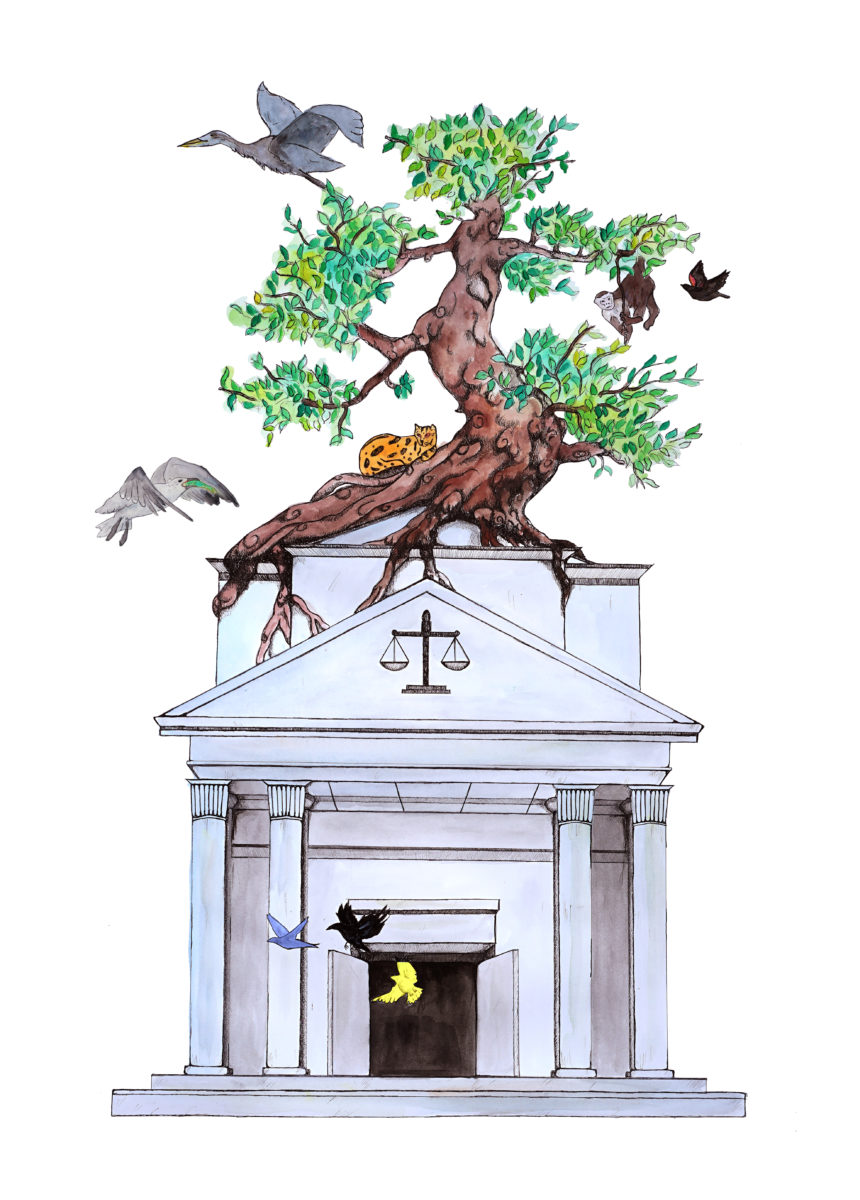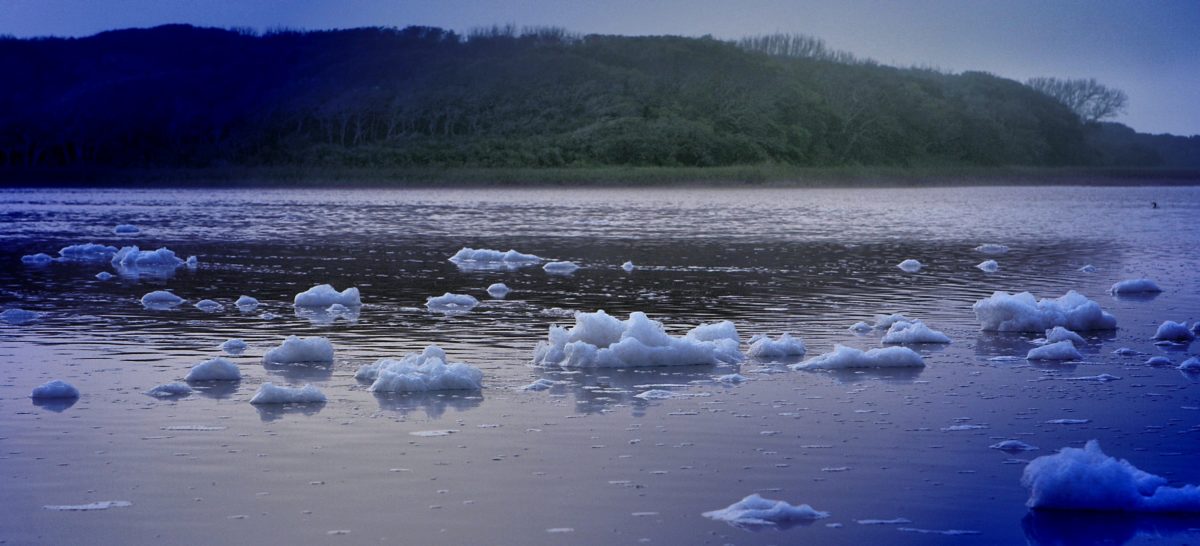
Nature is Above Human Courts and Systems of Law
Even though we are taught to believe that our laws and courts have the final say, we at CELDF have learned over the 25-plus years of working on advancing Rights of Nature laws that in the end, Nature will prevail.
The “scales of justice” on the courtroom face are shown in balance, contrasting with the very unbalanced place in which it is currently stuck. The courtroom is depicted as gray, colorless and lifeless, but the colorful birds flying out of the courtroom doors and the vivid colors of nature atop the courthouse depict how life-giving change can happen if we continue to challenge and fight for Nature’s rights, which in the end are also our rights—as we are part of Nature.
We at CELDF are honored and inspired by Blake and Tzintzun’s talent and work advancing Rights of Nature in their own community along the St. Lawrence River. And since the St. Lawrence is the gateway to the Atlantic Ocean from the Great Lakes, they are also following closely the Great Lakes Bill of Rights legislation introduced in the New York General Assembly this year.
Blake Lavia and Tzintzun Aguilar-Izzo together make up Talking Wings. Blake is a filmmaker, illustrator and author and Tzintzun is an environmental artist-scholar and story weaver, striving to plant the seeds of a regenerative future. This amazingly creative team was able to take CELDF’s verbal description of our Rights of Nature work and transform it into creative illustrations and logos to convey our message visually. Art has always played an important role in movements for systemic change.
It is our hope that their amazing artwork inspires you to continue to protect your community and the amazing ecosystems that you are interconnected with, and to remind you that CELDF is here to assist and support you moving forward.
Please consider donating
to keep this work moving forward.
Every contribution helps us champion the Rights of Nature
About CELDF’s Center for the Rights of Nature
CELDF is assisting civil society, indigenous peoples, communities, and governments to advance laws and policies for the protection of Nature and the environment. This includes providing legislative and policy drafting, legal research, public engagement and education, ongoing support during global crises, and trainings.
Communities in the United States and the country of Ecuador have also worked with CELDF to establish the first global laws protecting Nature. Today, we are working in India, Nepal, Australia, Cameroon, Colombia, the United States, and other countries to establish similar laws.
To learn more, please continuing reading below, and check out these helpful resources.
CELDF’s work on ecosystem rights recognition has been featured in mainstream and independent press publications across the globe, including on the Daily Show.
What ARE the Rights of Nature?
Environmental degradation is advancing around the world. The United Nations has warned that we are heading toward “major planetary catastrophe.” For this reason, there is a growing recognition that we must fundamentally change the relationship between humankind and nature.
Making this fundamental shift means acknowledging our dependence on nature and respecting our need to live in harmony with the natural world. It means securing the highest legal protection and the highest societal value for nature through the recognition of nature’s rights and associated human rights.

Nature Treated as Property. Photo Credit: Elizabethsalleebauer/RooMGetty/Images
The global Rights of Nature movement is gaining momentum. Read our Timeline.
The Human Right to a Healthy Environment
Many nations have expanded their body of legal rights to recognize a human right to a healthy environment, including Spain, France, Portugal, Greece, and Finland. However, global warming is accelerating and ecosystems are pushed to collapse.
Does Rights of Nature Mean ‘Personhood’?
One common misconception – including within elements of the Rights of Nature movement – is that organizers are advancing legal personhood for ecosystems. The truth is more complex. Read this conversation with The Guardian.
Rights of Nature Going Statewide
As the number of communities advancing Community Rights – including the Rights of Nature – grows, CELDF is assisting them in joining to form statewide Community Rights Networks. We are also partnering with these Networks to draft constitutional amendments to establish provisions for communities and Nature. Today, Colorado, New Hampshire, Oregon, and Ohio are advancing such constitutional amendments.
In 2019, Toledo, Ohio adopted the Lake Erie Bill of Rights – the first Rights of Nature law for a specific ecosystem. In March of 2020, the Pennsylvania Department of Environmental Protection (DEP) revoked a permit for a frack waste injection well in Grant Township. DEP officials cited Grant Township’s Home Rule Charter banning injection wells as grounds for their reversal.
Indigenous Traditional Knowledge
Aboriginal nations and communities retain sovereignty and knowledge over the natural ecosystems they have evolved with. To recognize and follow the natural laws of nature necessitates the elevation particularly of the Traditional Knowledge of local indigenous communities.
Rights of Nature Taking first International Steps
Following the first communities in the United States enacting Nature rights laws over a decade ago, the initiative became a growing global movement.
In 2008, CELDF was invited to meet with the Ecuador Constituent Assembly as they drafted a new constitution. We assisted the Assembly with constitutional provisions regarding Nature’s defense. Ecuadorians adopted their new constitution by an overwhelming majority, making Ecuador the first country in the world to recognize the Rights of Nature in its constitution.
Ecuador’s Rights of Nature constitutional provisions – found in Chapter 7 – state: “Nature, or Pachamama, where life is reproduced and occurs, has the right to integral respect for its existence and for the maintenance and regeneration of its life cycles, structure, functions and evolutionary processes. All persons, communities, peoples and nations can call upon public authorities to enforce the Rights of Nature.” Available Now: English Translation & Webinar of the 2022 Landmark Decision in Ecuador to Protect Los Cedros Forest over Mining Profits.
Watershed International Cases
The first cases have now been brought and litigated in Ecuador, where the courts upheld and affirmed the constitutional rights of ecosystems.
They include a lawsuit brought by Richard Frederick Wheeler and Eleanor Geer Huddle in the name of the Vilcabamba River. The river was a plaintiff in the case, seeking to enforce its own constitutional rights to exist and thrive. The healthy functioning and flow of the river was being impacted by a government road-widening construction project.
In 2011, the Provincial Justice Court of Loja ruled in favor of the Vilcabamba River. This marked the first time since that a court upheld Nature’s constitutional right to protection.
Rights of Nature Expanding Globally
Following Ecuador’s constitutional process, people and civil society in other countries learned about the movement. Today, CELDF’s International Center for the Rights of Nature is working in India, Nepal, Australia, Cameroon, Colombia, the United States, and other countries. We assist people, communities, and groups in advancing the protection of Nature’s rights. Over the past several years, CELDF has also traveled to Nepal, India, Colombia, and Australia. We have presented on Nature rights initiatives and help people and civil society launch related campaigns.
Bolivia
In 2010, Bolivia hosted the World People’s Conference on Climate Change and the Rights of Mother Earth. At the conference CELDF assisted in drafting the proposed Universal Declaration on the Rights of Mother Earth, modeled on the U.N. Universal Declaration on Human Rights. The Declaration on the Rights of Mother Earth has been presented to the U.N. General Assembly for its consideration.
Nepal
In Nepal, CELDF has been working with environmental and indigenous groups, and meeting with Parliamentarians. The goal is to amend the Nepal Constitution to recognize the Rights of Nature.
India
In 2014, CELDF traveled to Rishikesh in Uttarakhand, India, to partner with the Global WASH Alliance-India and Ganga Action Parivar. Together we developed the National Ganga River Rights Act. This is now being proposed to Prime Minister Modi’s administration. The Act would recognize rights of the Ganga River Basin and the people of India to a healthy river ecosystem.
United Kingdom
CELDF also assisted the Green Party of England and Wales to develop a Rights of Nature policy for their national party platform. The policy was adopted in February 2016.
Check out our Timeline on how this movement has grown.
A healthy environment is “one of the basic human rights.”
Rachel Carson

Photo: Global Warming in Guana by Craig ONeal, Flickr Creative Commons
Enforcing and Defending the Rights of Nature in the U.S.
In 2014, Grant Township, in the State of Pennsylvania, enacted a CELDF-drafted Community Bill of Right, recognizing the Rights of Nature. An oil and gas corporation sued the community to overturn the law.
In November 2014, CELDF filed a motion for the Little Mahoning Watershed to intervene in the lawsuit. This is the first time an ecosystem in the United States sought to defend its rights as recognized in municipal law. Its intervention is meant to defend its own legal right to exist and flourish. That case is ongoing.
In Highland Township, Pennsylvania, CELDF is also serving as legal counsel for a local watershed. The goal is to defend its rights not to have frack waste injected in its ecosystem.
Read more about emerging actions and discussions around the enforcement of Rights of Nature.
The Opposition
Wherever we work, the communities face harsh backlash from corporate and state interests. Learn more about one example.
CELDF Helping Advance a Movement
Solidarity is essential. Read a letter signed by Rights of Nature leaders and advocates across the globe, showing support for organizing efforts to defend the rights of Lake Erie.
WEBINARS
CELDF frequently hosts and contributes to global conversations on the Rights of Nature. Watch one:
Contribute to the Conversation
Are you working on Rights of Nature, environmental racism, indigenous governance, imaginative forms of community self-governance, state preemption, community engagement? Is your community impacted by issues around police accountability, houselessness, immigration, criminal justice reform, gender equality, racial inequality, healthcare access, equity in education, living wages, access to clean air and water, climate and environmental degradation? We welcome your guest blog contributions, to add and enlighten our conversations. The challenges we face demand solidarity, creativity, deep knowledge sharing, synthetic thinking, historical understanding, and a fusion of expertise and perspective. We, at CELDF, understand that we can broaden our vision by giving you the space to express yours.
Fight for the rights of nature, today.
Corporate-claimed “rights” to profits come at the cost of ecosystem rights to flourish. Please give today to help CELDF advance Rights of Nature. CELDF uses every dollar of your donation for this fight.
